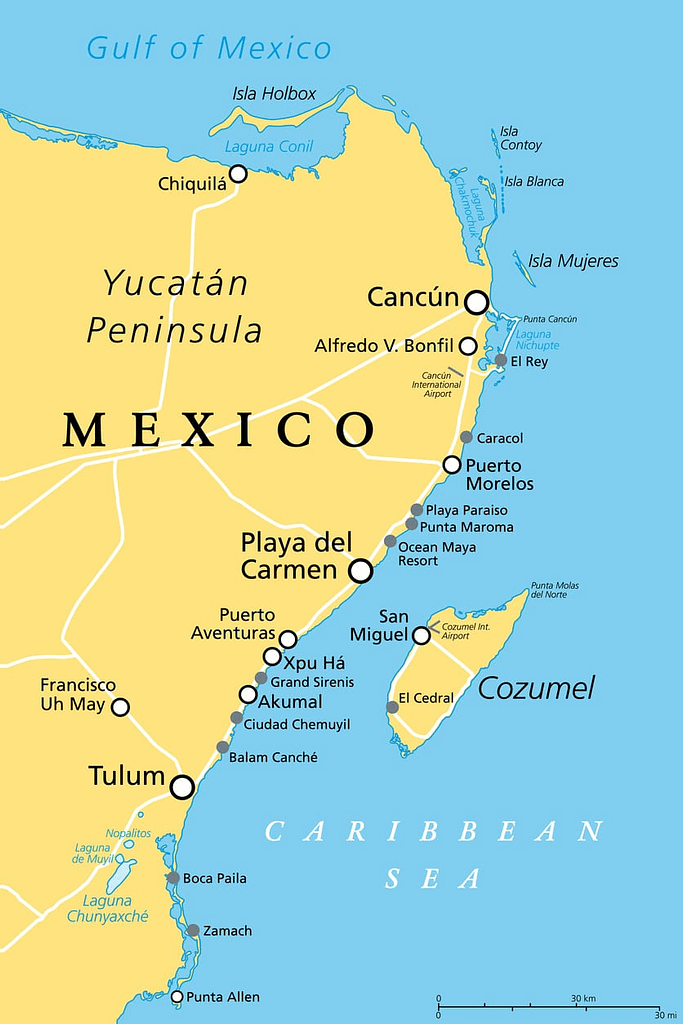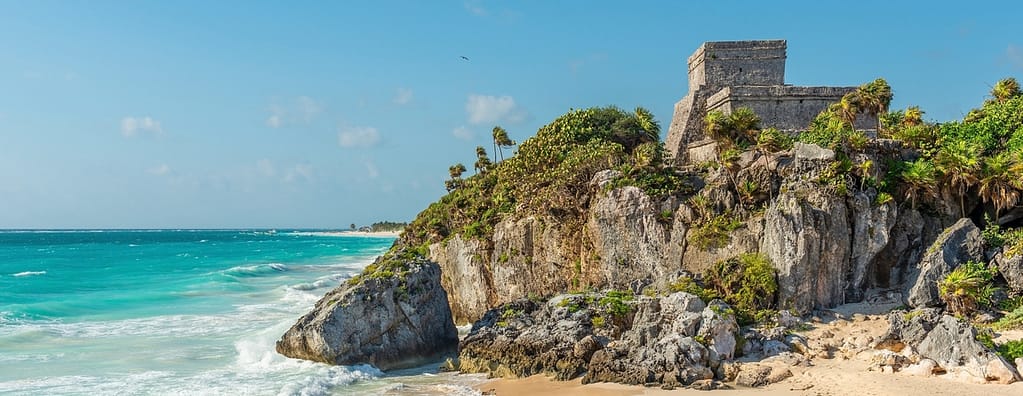Sustainable architecture prioritizes the health of its inhabitants and the environment. Because of talented and forward-thinking architectural artists who grasp this concept, Tulum retains its elusive magic.
Tulum’s early developers and the Mexican government took action to preserve Tulum’s boho vibe. And it remains in spite of the fact that Tulum has become one of the world’s hottest tourist destinations. It stands as a contrast to the built-up environs of Cancan and Playa del Carmen.
There was a fear that Tulum would lose its unique identity, becoming just another Quintana Roo tourist destination.

Cancún was the first village along to Quintana Roo’s Yucatan Peninsula to go mainstream in the 1970s. Multistory resort hotels built up and down its beaches made it the Miami of Mexico. It was chic and exciting, and tourism was good for the local economy. American Expats began to see the promise of retiring to Mexico, which further boosted the area’s economy. But Cancun’s rise from a sleepy fishing village to a purpose-built mass tourism resort came at a cost. Those who knew Cancan before would find the new Cancun completely unrecognizable. Those staying in its all-inclusive resorts or living in a luxe beachfront condo are some of the few able to enjoy prime beach access.
Playa del Carmen’s development brought about the next wave of Quintana Roo development in the 1980s. Playa’s popular Quinta Avenida (Fifth Avenue), located one block away from the beach, helped its developers to better preserve the beachfront. Today in Playa, most visitors and residents stay or live in apartments near the main avenue, lined with shops, restaurants and night life hotspots and walk to the beach to spend the day at one of the popular beach clubs. This helps Playa preserve its beach town atmosphere and more laid-back vibe. Even still, Playa’s atmosphere is distinctly urban.
Back in those days, people often travelled south along the coast on day trips to visit the ruins in remote and rustic Tulum. The Cancun to Tulum Corridor soon became known as the “Riviera Maya.” And it was only a matter of time before the wave of tourism threatened to wash over Tulum. By 1990, Tulum had grown in population from 92 people to about 2,000 people, rocketing to 12,000 by the millennium.


Talented artists intent upon seamlessly combining ancient insights and modern capabilities got to Tulum just in time! In 2011, the Papaya Playa Project became one of the first resorts to establish Tulum as an oasis for creative souls and wellness seekers. It didn’t have many amenities, or even electricity. It started as a collection of primitive huts on the beach. “Is there a better way to experience the beauty of nature than by sleeping in a tree house on some sunny stretch of Caribbean coastline surrounded by the jungle?” asked its owner and creator Emilio Heredia. He created a paradise for the adventurous traveler on one of the last pristine and original Mexican Caribbean coastlines.

Social entrepreneur Eduardo Neira (aka Roth) introduced Roth Architecture’s first project–“a hotel that became a universe–an interdisiplinary creative sphere.” Though not formally trained in architecture, Roth grew up in Argentina with two architect parents. The AZULIK group remains at the forefront of innovations in hospitality design.
Sustainable Architecture Learned From Ancestral Legacy
After moving to Tulum, Roth teamed up with the indigenous Mayan communities. They had been building on the jungle’s dense landscape for centuries. Instead of tearing down the landscape and creating a surface to build upon, Azulik sits atop stilts. This allows for nature to remain alive beneath it. Polished concrete, twisted bejuco vines, and thatched roofs comprise much of the hotel’s structure. Described as “textile architecture,” the structure is supported in a woven form, as if it were a basket. This approach, Roth says, has everything to do with the ancestral legacy. Indeed, native communities “weaved” their own narratives and interpretations of the environment. Like the Maya, Roth does not use machinery. Everything is manually handcrafted.
Papaya Playa Project began carefully began evolving to expand its offerings. The team knew it was time to get ready to serve the tourists who would be soon descending upon Tulum. The original cabanas at one end of the property got bathrooms and air conditioning. New villas, multi-story treehouse casitas and swimming pools were built. Truly, Papaya Playa Project by Design Hotel remained true to its roots. But at the same time it evolved into one of the most popular, trendy and expensive beach resorts in Tulum.
Design Piorneers Paved the Way for Mexico’s First Sustainable Tourism Zone
The works of Heredia and Roth were stunning, but there was still a fear that Tulum would still subject to losing its identity to become just another Quintana Roo tourist destination. Thus, in 2018, Tulum became “Mexico’s first sustainable tourism zone.” Height restrictions specified that buildings could be no taller than four floors plus rooftop (or under the tree line). Most significantly, Tulum’s structures and floating walkways are arranged around the natural landmarks instead of bulldozing through them. All this ensures that Tulum continues to be a contrasting alternative to the development status quo of Cancan and Playa del Carmen.
Tulum Inspires Like-Minded Developers
By 2020, the long-established yogi/hippie vibe of Tulum and the work of Heredia, Roth and others began to entice forward-thinking developers who relished the challenge and the opportunity that the development restrictions would ensure for Tulum. Indeed, Tulum Beach was the perfect location for Selina’s eco-chic design philosophy, offering both private and shared sleeping options on the same property. Built to accommodate the world’s digital nomads, Selina’s design philosophy blends accommodations with coworking, recreation, wellness, and local experiences. The Selina Los Lirios hotel opened in 2020. Accommodations ranging from impeccably designed boutique hotels, to jungle treehouses where people go to “nest with nature,” to beachfront huts and youth hostels soon began to pop up everywhere.
The Vibe, the History, Stellar Architecture…Checks All The Boxes for a Second Home
The efforts of Tulum’s pioneers to preserve and protect Tulum have paid off. Even as one of the world’s most popular tourist destinations, Tulum proves that it is destined and determined to remain one of the world’s most special places. Read more about the allure of modern day Tulum.
Tulum’s masterful example of sustainable architecture left The Savvy List’s founders wanting more and more. And we caught on just in time, purchasing in the first full scale master planned development by one Riviera Maya’s most active and successful developers. The plan is go often, but still make rental income by renting our second home in Tulum. Learn more.
